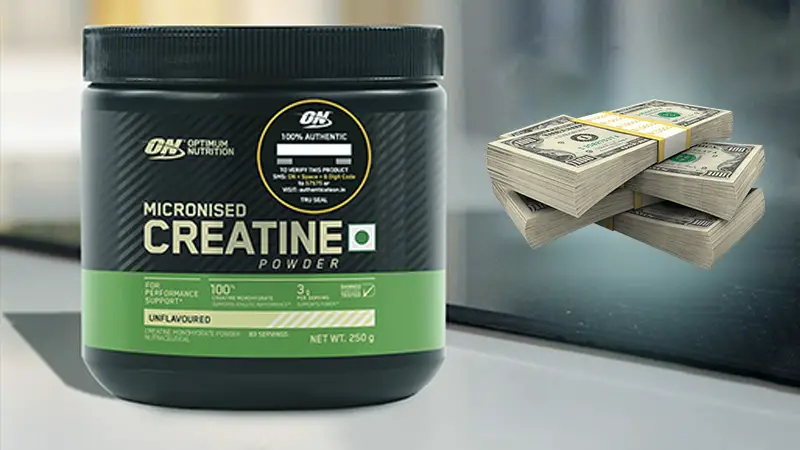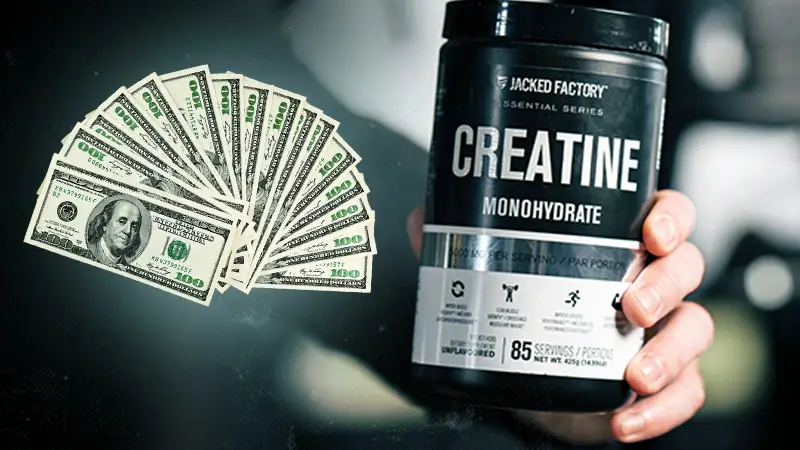The cost of creatine supplements has long been a subject of curiosity and sometimes frustration among fitness enthusiasts and athletes.
Creatine, a widely used and highly regarded supplement for enhancing muscle strength and performance, often comes with a price tag that raises questions.
In this introduction, we embark on an exploration of the reasons why is creatine so expensive.
The journey to understanding the cost of creatine leads us through various factors, including production costs, quality and purity standards, brand reputation, research and development, packaging, marketing, additional ingredients, import expenses, and certification and testing processes.
Each of these elements plays a role in shaping the retail price of creatine supplements. By unraveling these aspects, we aim to provide insight into the complex economics of creatine, empowering individuals to make informed choices and maximize the value of their supplement investments.
Why Is Creatine So Expensive?

Creatine’s cost can be influenced by various factors, which contribute to its price. Here are some reasons why creatine supplements might be relatively expensive:
Production Costs
The process of extracting and purifying creatine from natural sources, such as animal tissues or synthetically producing it, involves specific steps that can be labor-intensive and require specialized equipment, contributing to higher production costs.
Purity and Quality
High-quality creatine supplements are rigorously tested for purity and quality to ensure they contain minimal impurities. Meeting these quality standards can increase production expenses.
Brand Reputation
Well-established and reputable brands may charge more due to their trustworthiness and the perceived value of their products. Consumers often associate quality with higher prices.
Research and Development
Brands investing in research and development to create new and improved creatine formulations or delivery systems may pass on the costs to consumers.
Packaging and Marketing
Attractive packaging and marketing campaigns can add to the overall cost of creatine supplements. Eye-catching labels and advertising can drive up expenses.
Additional Ingredients
Some creatine products are combined with other supplements or ingredients, such as amino acids or electrolytes, which can increase the price due to the complexity of the formulation.
Flavoring and Additives
Creatine supplements with added flavors, sweeteners, or texture enhancers are often pricier than unflavored alternatives, reflecting the cost of these additional ingredients.
Import Costs
If the creatine is sourced from international suppliers, import taxes, shipping fees, and currency exchange rates can influence the final retail price.
Certifications and Testing
Some creatine brands may undergo third-party testing and certification to verify the product’s safety and effectiveness. These extra steps can add costs to the manufacturing process.
Creatine’s expense can be attributed to various factors, including production costs, quality and purity standards, brand reputation, research and development, packaging, marketing, additional ingredients, import expenses, and certification and testing processes.
While there are budget-friendly creatine options available, consumers often find that the cost reflects the product’s quality and the brand’s reputation in the market.
How To Find A Cost-Effective Creatine?

Finding cost-effective creatine supplements requires a combination of research, smart shopping, and understanding your specific needs. Here are some ways to discover affordable yet high-quality creatine options:
Compare Prices Online
Utilize online platforms and websites to compare prices from different retailers. Look for reputable online stores and check for discounts, bulk purchase deals, or seasonal promotions, which can significantly reduce the overall cost.
Consider Bulk Purchases
Buying creatine in bulk, such as larger containers or multi-month supplies, often results in a lower cost per serving. This approach can save you money in the long run, especially if you’re a regular user.
Look for Unflavored Variants
Unflavored creatine powders are usually more affordable than flavored versions. By choosing unflavored creatine, you get the same benefits without the added cost of artificial flavorings and sweeteners.
Check Generic or Store Brands
Generic or store-branded creatine supplements often provide the same active ingredient at a lower price point compared to well-known brands. Read the labels to ensure the product meets your requirements and standards.
Avoid Fancy Additives
Opt for straightforward creatine monohydrate without unnecessary additives or additional supplements. While some products come with added ingredients, these can increase the cost without necessarily enhancing the effectiveness of the creatine itself.
Utilize Subscription Services
Some online retailers offer subscription services that provide regular deliveries of your chosen creatine supplement. Subscribers often receive discounts, making it a cost-effective and convenient option for long-term use.
Read Reviews and Seek Recommendations
Research user reviews and seek recommendations from reliable sources or fitness communities.
People often share their experiences with different creatine supplements, helping you find a product that offers good value for money while delivering the desired results.
By employing these strategies, you can identify cost-effective creatine options that align with your budget without compromising on quality or effectiveness.
It’s essential to strike a balance between affordability and product reliability to ensure you’re getting the best value for your investment in your fitness journey.
How To Save Money When Using Creatine?

Saving money while using creatine supplements is a smart approach to maintaining your fitness routine without straining your budget. Here are some tips to help you cut costs without compromising your gains:
Buy in Bulk
Purchasing creatine in larger quantities often results in a lower cost per serving. Look for larger containers or multipacks, especially during sales or promotions, to save money in the long term.
Opt for Powder Form
Creatine powder is generally more cost-effective than capsules or ready-to-drink solutions. Buying creatine in its pure powder form allows you to control the dosage and save on packaging costs.
Choose Unflavored Variants
Flavored creatine products tend to be more expensive due to the added ingredients for taste. Unflavored creatine is just as effective and typically costs less. You can mix it with your preferred beverage for flavor.
Store Brands and Generic Options
Explore store brands or generic versions of creatine supplements. These products often provide the same active ingredient as name brands at a lower price without compromising quality.
Utilize Sales and Discounts
Keep an eye on sales, discounts, and special offers from online and local retailers. Many stores run promotions or offer loyalty programs that can lead to significant savings on creatine supplements.
Avoid Overcomplicated Formulas
Stick with straightforward creatine monohydrate. Avoid products with excessive additives or additional supplements. While these can increase the cost, they may not necessarily enhance the effectiveness of the creatine.
Manage Your Dosage
Follow the recommended dosage guidelines to prevent wastage. Using the correct amount ensures you get the desired benefits without overusing the product and incurring unnecessary costs.
By implementing these money-saving strategies, you can continue to incorporate creatine into your fitness regimen while staying within your budget.
It’s essential to strike the right balance between cost savings and product quality to achieve your fitness goals economically and efficiently.
FAQs
Why is creatine more expensive than some other supplements?
Creatine’s price is influenced by various factors, including production costs, quality standards, brand reputation, and marketing. The unique production process, quality control, and research behind creatine supplements often contribute to a higher price compared to simpler supplements.
Are there cheaper alternatives to expensive creatine supplements?
Yes, there are cost-effective creatine options available. Choosing unflavored variants, store brands, or buying in bulk can help reduce costs without compromising quality. It’s essential to read labels and consider factors like purity and effectiveness.
Does a higher price always mean better quality in creatine supplements?
Not necessarily. While some higher-priced creatine products may offer quality and reputation, cost-effective options can also provide effective results. It’s important to evaluate the specific product’s features, including ingredients and certifications, rather than relying solely on price.
Do additional ingredients and flavorings make creatine more expensive?
Yes, flavorings, additives, and additional ingredients can increase the cost of creatine supplements. Unflavored creatine is often more budget-friendly, and while flavorings enhance taste, they may not necessarily improve the core benefits of creatine.
Can sales and discounts help reduce the cost of creatine supplements?
Absolutely. Many retailers offer promotions, discounts, and loyalty programs that can significantly lower the cost of creatine. Keeping an eye on sales and taking advantage of discounts can be an effective way to save money while still benefiting from creatine supplementation.
Conclusion
The expense of creatine supplements can be attributed to a combination of factors, each contributing to the overall cost.
From the production processes that involve extraction and purification to the investments in research and development, quality testing, and marketing, creatine’s price is a reflection of various inputs.
While it’s true that creatine can be relatively expensive, it’s crucial to recognize that not all creatine products are equally priced, and there are options to suit different budgets.
Individuals looking to manage costs while obtaining the benefits of creatine can explore alternatives like unflavored versions, generic or store brands, and bulk purchases.
By understanding the factors that influence the price, consumers can make informed choices that align with their budget and still achieve their fitness and performance goals.
Ultimately, the cost of creatine is a multifaceted matter that warrants consideration from various angles, allowing users to strike a balance between value and effectiveness.
Hi, I’m Mark Pattinson and I’m a freelance personal trainer. I’ve been working in the fitness industry for over 10 years especially since I work with diabetes patients and I love helping people achieve their fitness goals. I believe that everyone can benefit from a good workout, and I’ll do everything to make sure you get the most out of your training.